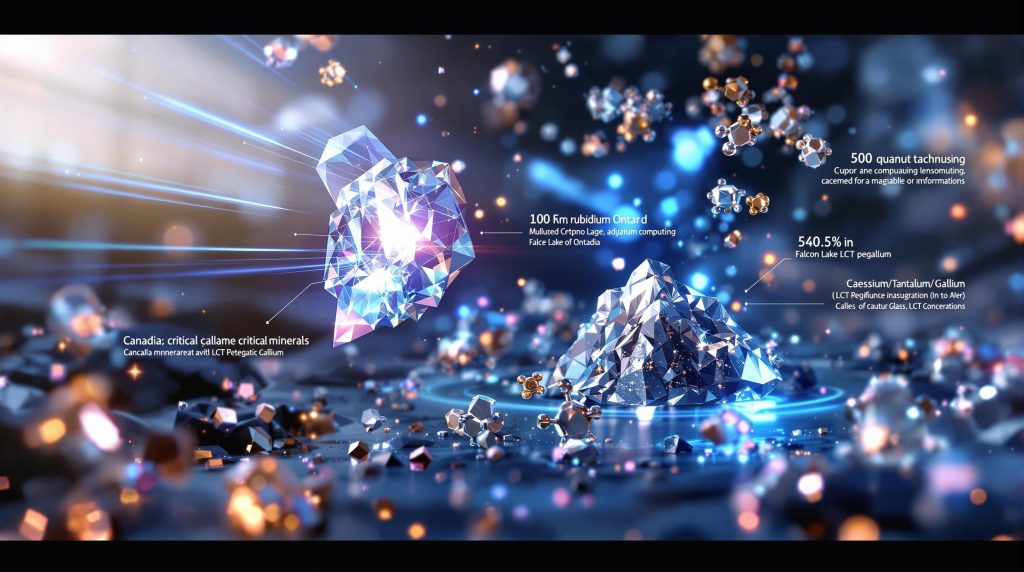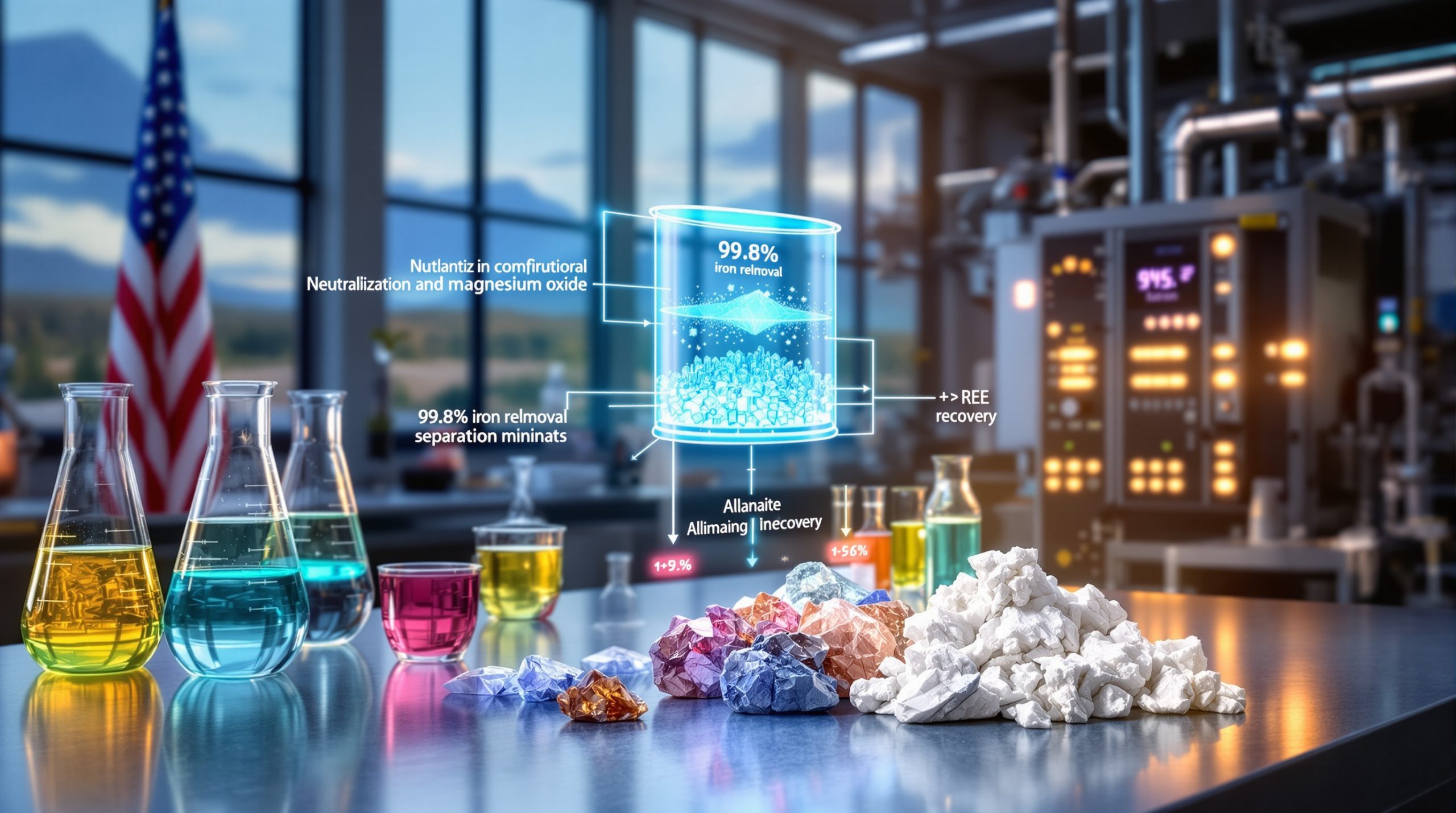Exploring Rubidium Potential at Falcon Lake: Battery Age Minerals' Critical Mineral Discovery
High-grade rubidium findings at Battery Age Minerals' Falcon Lake project have positioned the company as a potential supplier of critical minerals energy transition essential for next-generation technologies. Recent assays have confirmed significant concentrations of rubidium alongside other valuable elements, establishing the project as more than just a lithium play.
What Is Rubidium and Why Is It Becoming a Critical Mineral?
Rubidium remains one of the less familiar elements on the periodic table, yet its importance in high-technology applications is growing rapidly. This soft, silvery-white alkali metal occupies a unique position in the critical minerals landscape.
Understanding Rubidium's Properties and Applications
Rubidium (Rb) is a soft, highly reactive alkali metal with distinctive properties that make it valuable across several specialized sectors. As one of the most electropositive elements, it readily donates electrons, making it particularly useful in technical applications.
The element's most promising applications include:
- Quantum computing technologies – Rubidium atoms are used in quantum computing research for their stable energy states
- Fiber optic telecommunications – Rubidium vapor is utilized in certain high-performance signal amplification systems
- Specialized glass manufacturing – Adding rubidium improves electrical conductivity and stability in specialty glass products
- Defense applications – Used in night vision technology and specialized electronics
- Atomic clocks – Rubidium frequency standards provide reliable timekeeping for GPS and telecommunications systems
Despite limited awareness among general consumers, rubidium has become increasingly important for industries developing cutting-edge technologies that demand its unique properties.
Why Rubidium Is Gaining Strategic Importance
Several factors have elevated rubidium's profile as a strategically important element:
-
Officially designated as a critical mineral in multiple jurisdictions:
- Canada's Critical Minerals Strategy
- United States Critical Minerals Assessment
- Japan's Strategic Resource Initiative
-
Supply constraints are significant:
- No large-scale primary production facilities currently exist globally
- Typically recovered as a by-product of lithium or caesium mining operations
- Limited processing expertise and facilities worldwide
-
Economic value is substantial:
- High-purity rubidium compounds can command premium prices exceeding US$1,000 per kilogram
- Specialized applications require exceptional purity levels
- Limited substitutes exist for many technical applications
The growing demand from emerging technology sectors coupled with constrained supply has created a strategic opportunity for companies that can develop reliable rubidium resources in stable jurisdictions.
What Has Battery Age Minerals Discovered at Falcon Lake?
Battery Age Minerals' exploration work at Falcon Lake has revealed a potential multi-commodity resource with significant concentrations of several critical minerals, extending beyond the project's initial lithium focus.
Key Findings from Multi-Element Assays
Recent comprehensive testing at the Falcon Lake project has confirmed impressive concentrations of multiple critical minerals:
-
Significant rubidium values:
- Peak rubidium readings reaching 11,400 parts per million (1.14%)
- More than one-third of samples exceeded 2,000ppm rubidium
- Consistent mineralization across multiple zones
-
Additional critical minerals detected:
- Caesium values peaking at 2,600ppm
- Tantalum concentrations reaching 2,300ppm
- Gallium readings up to 95.6ppm
These results complement earlier drill results interpretation that identified thick zones of high-grade spodumene, positioning Falcon Lake as both a premier lithium asset and a potential multi-metal resource.
"These exciting results demonstrate the project's multi-commodity potential at a time of strong global demand for battery and high-technology inputs," Battery Age Minerals CEO Nigel Broomham stated when announcing the findings.
The multi-element nature of the discovery potentially enhances the project's economic viability by providing multiple revenue streams from a single operation.
Geological Context of the Discovery
The Falcon Lake project is strategically located within Ontario's established lithium corridor, a region known for hosting significant critical mineral deposits. Several geological factors make this discovery particularly noteworthy:
- Located within a well-established mining district with excellent infrastructure
- Project features characteristics consistent with highly evolved Lithium-Caesium-Tantalum (LCT) pegmatite systems
- Comparable to established operations like:
- The Tanco mine in Manitoba, known for producing cesium and tantalum
- Green Technology Metals' Aubry pegmatites
The exploration progress to date represents just the beginning of the project's potential:
- Only 5 of 30 high-priority targets have been drill-tested
- Mineralization occurs within a 5-kilometer corridor that remains largely open
- Multiple spodumene-bearing pegmatites confirmed at different locations
The geological setting suggests significant potential for additional discoveries, with only a fraction of the property systematically explored thus far.
How Does This Compare to Other Critical Mineral Projects?
Understanding how the Falcon Lake discovery compares to other critical mineral projects provides important context for assessing its potential significance in the global supply chain.
Benchmarking Against Similar Deposits
The Falcon Lake project displays several characteristics that align with premium critical mineral deposits globally:
-
Mineral assemblages: The project shows the hallmark mineral combinations typical of highly fractionated pegmatites, with elevated rubidium grades comparing favorably to by-product streams at operating mines.
-
Element distribution: The multi-element potential mirrors characteristics of premium LCT pegmatite systems worldwide, with rubidium, caesium, tantalum, and gallium occurring alongside lithium.
-
Economic potential: The presence of multiple critical minerals enhances overall project economics compared to single-commodity deposits, with the combination of lithium and high-value critical metals creating a strategic advantage.
-
Exploration maturity: With only 5 of 30 targets tested, the project remains at an early stage with significant upside potential compared to more mature operations.
The geological setting suggests potential for additional discoveries within property boundaries, which could further enhance the project's scale and economic viability.
Market Positioning and Strategic Value
Several market factors contribute to the strategic value of the Falcon Lake discovery:
-
The rubidium market is characterized by limited supply and specialized applications, creating potential premium pricing opportunities for new producers.
-
Caesium similarly faces supply constraints with high-tech applications, further enhancing the project's value proposition.
-
Tantalum remains critical for electronics manufacturing and capacitors, with established markets and pricing mechanisms.
-
Gallium demand is increasing for semiconductor applications, particularly in the growing renewable energy mining solutions.
The multi-commodity potential provides a natural hedge against individual metal price fluctuations, potentially reducing investment risk compared to single-commodity projects.
Additionally, the project's strategic location in Ontario's mining-friendly jurisdiction enhances development potential, with established infrastructure and regulatory frameworks supporting potential advancement.
What Are the Economic Implications of Critical Mineral By-Products?
The presence of multiple valuable elements at Falcon Lake creates intriguing economic possibilities beyond the project's lithium foundation.
Potential Revenue Enhancement from By-Products
The economic impact of recovering multiple critical minerals could significantly enhance the Falcon Lake project's financial profile:
-
Premium pricing potential:
- High-purity rubidium compounds can command prices exceeding US$1,000 per kilogram
- Caesium and tantalum also command premium prices in specialized markets
- Gallium provides additional value recovery potential
-
Risk mitigation advantages:
- Multiple revenue streams reduce overall financial risk
- Diversification protects against price volatility in any single commodity
- Staggered market cycles between different minerals may provide stability
-
Value-added opportunities:
- Processing to higher-purity products could substantially increase returns
- Specialized end-products may command significant premiums
- Integration into supply chains for high-tech manufacturers
The ability to monetize what would otherwise be waste material in a conventional lithium operation could transform the project economics, potentially reducing the effective cost of lithium production through valuable by-product credits.
Processing Considerations and Recovery Potential
Realizing the full economic potential of Falcon Lake's multi-element mineralization will require careful consideration of processing approaches:
-
Metallurgical complexity:
- Efficient recovery of multiple elements requires specialized processing expertise
- Separation and purification technologies must be optimized for each target element
- Balancing recovery rates across multiple elements presents technical challenges
-
Processing pathways:
- Potential for parallel production streams:
- Primary lithium (spodumene) concentrate
- Rubidium compounds
- Caesium products
- Tantalum concentrate
- Gallium recovery
- Potential for parallel production streams:
-
Economic trade-offs:
- Capital costs for multi-element recovery must be balanced against revenue potential
- Operational complexity increases with each additional recovery circuit
- Market development may be required for specialized products
Battery Age Minerals has indicated that metallurgical test work is planned to assess recovery options for the various elements, which will provide critical information about the technical and economic feasibility of multi-element recovery.
What's Next for the Falcon Lake Project?
With encouraging initial results, Battery Age Minerals has outlined a comprehensive path forward to advance the Falcon Lake project.
Upcoming Exploration Activities
The exploration program at Falcon Lake is set to expand significantly:
-
Target expansion:
- Implementation of advanced geochemical exploration techniques
- Utilization of specialized geophysical methods to identify new targets
- Systematic evaluation of the property's full critical mineral potential
-
Drilling program expansion:
- Plans to test the remaining 25 high-priority targets
- Potential to extend known mineralization along the 5-kilometer corridor
- Deeper drilling to test vertical continuity of mineralized zones
-
Technical assessments:
- Detailed mineralogical studies to understand element distribution
- Structural analysis to better predict pegmatite orientations
- Three-dimensional modeling of mineralized zones
This systematic approach aims to define the full extent of mineralization across the property, potentially expanding the resource base significantly beyond current known zones.
Development Pathway and Milestones
Beyond exploration, several key development activities will advance the project:
-
Technical studies:
- Metallurgical test work to assess recovery of multiple elements
- Evaluation of processing options for rubidium and other critical minerals
- Resource definition drilling to establish mineral inventory
-
Economic evaluation:
- Preliminary economic assessment incorporating multi-element recovery
- Evaluation of development scenarios at various production scales
- Market studies for specialized elements like rubidium and caesium
-
Regulatory advancement:
- Permitting and environmental baseline studies
- Stakeholder engagement and community relations initiatives
- Sustainable development planning
The company will need to balance advancing the lithium aspects of the project while simultaneously evaluating the economic potential of the critical mineral by-products, potentially creating a phased development approach that optimizes capital efficiency.
How Do Critical Minerals Support the Energy Transition?
The critical minerals identified at Falcon Lake play vital roles in technologies driving the global energy transition and digital transformation.
The Role of Specialized Metals in Advanced Technologies
Each of the critical minerals found at Falcon Lake contributes to different aspects of the technological revolution:
-
Rubidium applications:
- Quantum computing components support next-generation data processing
- Photocells and specialized electronic devices
- Ultra-precise atomic clocks essential for telecommunications and navigation
-
Caesium contributions:
- Used in specialized drilling fluids for deep-well operations
- Atomic clock technology
- Specialized catalysts and medical applications
-
Tantalum importance:
- Critical for miniaturized electronics and capacitors
- Essential components in electric vehicle systems
- Medical implants and aerospace applications
-
Gallium essentials:
- Semiconductor manufacturing
- Solar cell efficiency enhancement
- LED lighting technology
- 5G telecommunications infrastructure
-
Lithium foundation:
- Remains fundamental to battery technology
- Electric vehicle power systems
- Grid-scale energy storage
- Portable electronics
The integration of these elements into modern and emerging technologies creates a complex demand picture, with each element playing specialized roles in enabling the transition to more sustainable and advanced technological systems.
Supply Chain Security and Geopolitical Considerations
The concentration of critical mineral production in a limited number of countries has created supply chain vulnerabilities that new discoveries like Falcon Lake could help address:
-
Supply diversification initiatives:
- Western nations are prioritizing domestic critical mineral production
- Canada is positioning itself as a secure supplier of technology metals
- Ontario's stable mining jurisdiction offers regulatory predictability
-
Strategic resource development:
- Reducing dependency on concentrated supply sources
- Projects with multiple critical minerals provide strategic advantages
- Growing government support for critical mineral development
-
Policy environment:
- Investment incentives for critical mineral projects
- Expedited permitting considerations for strategic resources
- Research and development support for processing technologies
The Falcon Lake project's location in Canada aligns with broader efforts to establish secure supply chains for critical minerals in politically stable jurisdictions with strong environmental and social governance frameworks.
What Investment Considerations Apply to Critical Mineral Projects?
Investing in critical mineral projects like Falcon Lake involves understanding several unique factors that distinguish these opportunities from conventional commodity investments.
Key Factors Influencing Project Economics
Several important considerations impact the potential economics of critical mineral projects:
-
Foundation and enhancement structure:
- Primary lithium potential provides foundation for development
- Critical mineral by-products potentially enhance overall returns
- Balancing capital allocation between primary and secondary recovery
-
Market dynamics:
- Processing complexity versus premium pricing considerations
- Market size constraints for specialized elements like rubidium
- Relationship development with specialized end-users
-
Development parameters:
- Timeline and capital requirements
- Technical expertise requirements
- Processing technology selection
- Exploration upside with 25 untested high-priority targets remaining
The economic success of critical mineral projects often depends on efficiently recovering multiple elements from the same resource, which requires careful optimization of technical and market approaches.
Risk Factors and Mitigation Strategies
Investors should consider several risk factors specific to critical mineral projects:
-
Market development challenges:
- Specialized markets require relationship development
- Limited number of end-users for certain elements
- Qualification requirements for high-purity products
-
Technical considerations:
- Processing technology selection critical for recovery optimization
- Metallurgical performance will determine economic viability
- Balancing focus between lithium and critical mineral by-products
-
Strategic approaches:
- Staged development approach may optimize capital efficiency
- Strategic partnerships could accelerate commercialization
- Off-take agreements may be necessary to secure financing
For Battery Age Minerals specifically, the project's multi-commodity nature provides natural risk mitigation through diversification, while the project's location in a premier mining jurisdiction reduces regulatory and operational risks.
FAQ About Rubidium and Critical Minerals
What makes rubidium a critical mineral?
Rubidium is classified as a critical mineral due to its essential applications in advanced technologies, limited production sources, and strategic importance. Its designation by multiple countries including Canada, the United States, and Japan reflects growing concerns about supply security for specialized technology metals. The element's applications in quantum computing, fiber optics, and defense technologies, combined with extremely limited primary production globally, create a strategic imperative to develop secure supply sources.
How is rubidium typically extracted and processed?
Rubidium is primarily recovered as a by-product from lithium or caesium mining operations. The extraction process typically involves specialized hydrometallurgical techniques to separate rubidium from other elements. After initial concentration, the material undergoes multiple purification steps to achieve the high purity levels required for technical applications. The complexity of rubidium processing contributes to its premium pricing, with high-purity compounds commanding prices exceeding US$1,000 per kilogram.
What are the primary industrial applications for rubidium?
Rubidium finds applications in quantum computing systems, specialized glass manufacturing, fiber optic telecommunications, atomic clocks, certain medical imaging technologies, and various defense applications. Its unique properties make it valuable for highly specialized technical uses rather than mass-market applications. As quantum computing advances and telecommunications infrastructure expands, demand for high-purity rubidium compounds is projected to increase across several high-tech sectors.
How does the discovery of multiple critical minerals impact project economics?
The presence of multiple critical minerals can significantly enhance project economics by providing additional revenue streams beyond the primary commodity. This diversification reduces financial risk, improves overall returns, and makes projects more resilient to price fluctuations in any single commodity market. For projects like Falcon Lake, the potential to recover rubidium, caesium, tantalum, and gallium alongside lithium creates opportunities for value optimization through integrated processing approaches that maximize recovery of all valuable elements.
What challenges exist in developing rubidium as a by-product?
Key challenges include developing efficient direct lithium extraction and purification processes, establishing market connections for specialized products, managing the complexity of multi-element recovery, and balancing capital investment against potential returns. The specialized nature of rubidium markets requires targeted marketing strategies and quality control measures to meet the exacting specifications of high-tech applications. Companies must also develop relationships with specialized end-users who may require qualification procedures before accepting new supply sources.
Disclaimer: This article contains information about mineral exploration results and potential future developments. Mineral exploration is inherently uncertain, and there is no guarantee that resources discusse
Ready to Spot the Next Big Mineral Discovery?
Discovery Alert's proprietary Discovery IQ model instantly identifies significant ASX mineral discoveries, providing real-time alerts that give you a critical market advantage. Visit our discoveries page to see how major mineral discoveries have generated substantial returns and start your 30-day free trial today.




